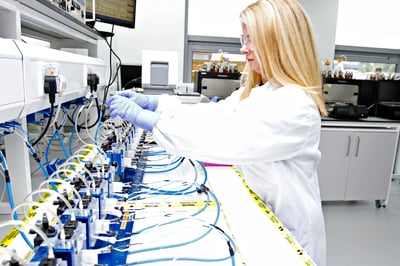Ion Channel Function Assays
At REPROCELL, we provide solutions for studying ion channel function using our advanced Ussing chamber system. This tool detects changes in ion channel activity and exchange mechanisms, critical for understanding drug interactions within gastrointestinal tissues. By measuring short circuit current (Isc, µAmps), our assays predict the effects of your test articles on ion channel function, especially in the gastrointestinal tract, where ion channels regulate fluid secretion.
Key Features of Our Ion Channel Function Assays
- Comprehensive Testing — compounds are tested in duplicate at six different concentrations for robust and reliable data.
- Diverse Tissue Analysis — we use various regions of the gastrointestinal tract, offering a thorough understanding of regional differences in ion channel activity and drug interaction.

Image: One of our scientists operating an Ussing chamber in our Glasgow laboratory.
Importance of Gastrointestinal Models in Drug Discovery
Orally administered drugs are the most common form of therapy. As development costs increase, models that predict human bioavailability early in the process are invaluable. The intestine is crucial for drug absorption and first-pass metabolism, influencing oral bioavailability. Traditional approaches often fail to replicate the complex biology of the human small intestine, the primary site of drug absorption.
Ussing Chamber: A Superior System for Drug Development
The Ussing chamber offers a system where both permeability and metabolism can be assessed simultaneously. This is essential because common models like the Caco-2 cell line, while useful for predicting passive absorption, fall short due to low expression of metabolic enzymes. Similarly, subcellular fractions or intestinal slices can predict metabolic instability but cannot accurately reflect permeability due to the lack of an intact cell membrane or barrier.
- Permeability Assessment: The apparent permeability (Papp) can be calculated in vitro using human intestinal mucosa, reflecting permeability irrespective of the transport mechanism.
- Intestinal Metabolism: Once a drug enters the enterocyte, it may undergo Phase I and Phase II metabolism, which can be measured in the Ussing chamber using human intestinal tissues. This is particularly relevant for Phase I metabolism controlled by CYP enzymes like CYP3A4, predominantly expressed in the small intestine.

Detailed Methodology
The Ussing chamber technique involves two chambers separated by intact tissue from the stomach, small intestine, or large intestine. Tissue integrity and viability are assessed through electrical resistance measurements (transepithelial electrical resistance, TEER), potential difference, and basal short circuit current (Isc). High-quality tissues are sourced ethically from surgical procedures or organ donors and maintained in a physiological saline solution during transport.
- Experimental Setup: Tissues are mounted in the Ussing chamber, equilibrated at 37°C, and solutions are gassed with 95% O2 / 5% CO2. Electrical parameters are continuously monitored, and TEER values are recorded every 2-5 minutes.
- Drug Testing: Drugs are added to one chamber, and samples are taken at various time points to assess permeability and metabolic interactions.
Commitment to Quality
All tissues used in our assays undergo stringent quality checks for viability and functionality. TEER and potential difference are measured continuously throughout the experiment to ensure reliable results. Tissues that do not meet our rigorous standards are not used, ensuring no charges for suboptimal samples.
At REPROCELL, we are committed to providing high-quality, reliable data to support your drug discovery efforts. Our advanced ion channel function assays using the Ussing chamber system offer unparalleled insights into drug absorption and metabolism, enhancing the predictive accuracy of human bioavailability and supporting the development of effective oral therapies.
Ion channel function assays in our catalog
This assay uses intestinal mucosa to assess the effects of your test article on chloride channels in the gastrointestinal tract.